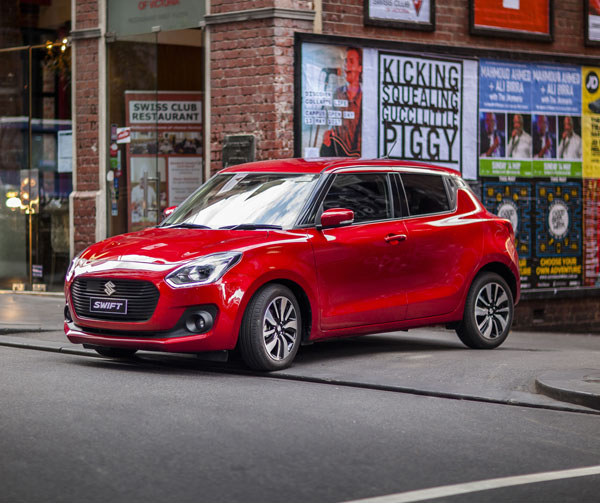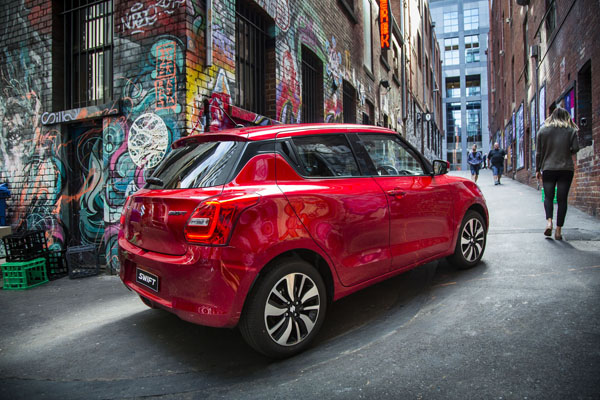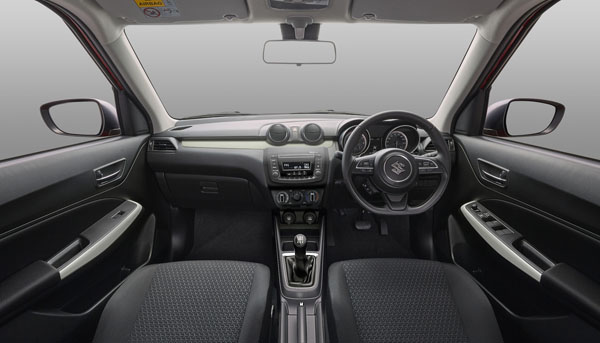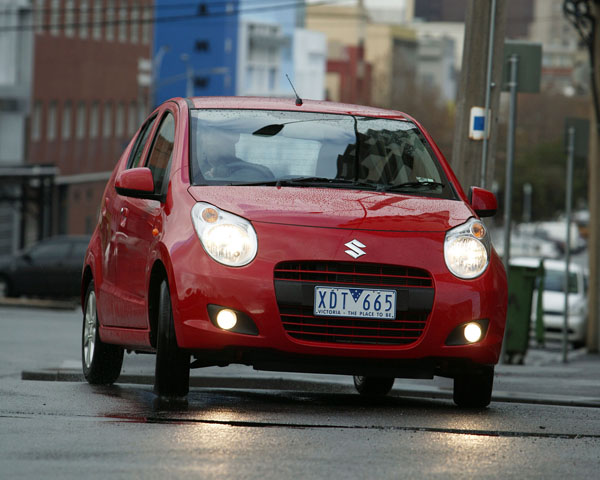 The latest Suzuki Swift displays the Japanese company’s history of engineering excellence with a particularly well-sorted drivetrain. Its 1.2-litre four-cylinder engine, mated with an excellent CVT, is a real delight to sit behind.
The latest Suzuki Swift displays the Japanese company’s history of engineering excellence with a particularly well-sorted drivetrain. Its 1.2-litre four-cylinder engine, mated with an excellent CVT, is a real delight to sit behind.
Our test car, the Suzuki Swift GL Navigator with Safety Pack, provided seamless and seemingly effortless operation in almost all circumstances.
STYLING
The new Swift has taken on a more assertive look, especially up front, with a wide open radiator and lower bumper grille making a positive statement.
Fenders add more muscle to a lower and wider stance, while blacked out pillars give the impression of a floating roof. Rear door handles ‘hidden’ in the C-pillar again follow the modern design trend without taking anything away for the Swift character.
Swift GL Navigator grades feature multi-reflector halogen headlamps, with LED daytime running lamps in the front bumper
The 16-inch alloy wheels come with low rolling resistance tyres designed to minimise fuel use, but still deliver a high level of comfort.
INFOTAINMENT
A 7.0-inch four-quadrant touch screen positioned at driver’s eye level on the central dashboard, enables easy access to audio and video playback and hands-free phone and navigation. Thanks to Apple CarPlay and Android Auto, the driver can also connect a smartphone.
ENGINES / TRANSMISSIONS
The 1.2 Dualjet engine’s main aim is to increase fuel efficiency. An ultra modern unit, it has two injectors per cylinder supplying atomised fuel, which is easier to burn, allows very-stable combustion and higher thermal efficiency.
The CVT uses two pulleys linked by a belt, rather than using a fixed number of gears as in a conventional automatic. The CVT changes ratios moment by moment, selecting from a virtually infinite number between its lowest and highest ratios to get the best from the engine in all driving conditions.
SAFETY
Six airbags are standard across the new Swift range. Active safety takes in electronic stability control, ABS anti-skid braking with electronic brake-force distribution and brake assist.
However, the Swift GL Navigator 1.2 is available with a Safety Pack, Suzuki’s first application of a forward crash detection system using the combination of a camera and laser sensor attached to the windshield.
The camera can detect objects such as pedestrians and lane markers mid to long distances ahead, while the laser picks up obstacles closer in or at night. If there is a risk of collision an audio warning sounds and visual warning comes up on the multi-information display directly in front of the driver.
If the system determines there is a high risk of collision and the driver panic brakes – but doesn’t hit the pedal hard enough – it will bring in maximum braking force to avoid a collision, or at least minimise damage.
Further enhancing active safety are lane departure warning, weaving alert and another Suzuki first, high beam assist.
DRIVING
Going against the segment trend the new Suzuki Swift is shorter than the superseded model. However, with 20 mm added to the wheelbase cabin space is not compromised.
In keeping with a lower overall vehicle height, lowering the seating maintains adequate head room and added lateral space for the rear seats. The front seats have been separated by a further 10 mm, creating more distance between driver and passenger.
Cleverly, the new Swift’s 242 litres of luggage space is 32 litres more than the old. The area has been upgraded to carry a wider range of cargo, which is made easy to load and unload thanks to a high-lift tailgate. There’s a space-saver spare to maximise boot space.
The tiny-tot 1.2-litre engine dishing up a mere 66 kW and 110 Nm, took full advantage of the CVT efficiency and coped splendidly with a range of loads and varied driving styles from stop-start city traffic to cruising the open road.
With claimed fuel consumption of 4.8 litres per 100 kilometres on the combined urban / highway cycle, on test the Swift GL 1.2 recorded 5.4 litres per 100 kilometres around town and down to a minuscule 3.7 litres per kilometre on the motorway.
A new underbody, 30 kg lighter than the one it replaces, contributes to lower fuel consumption and better performance in terms of acceleration, turning and stopping.
Swift is very much a global car and European engineers came to the party to join Japanese and others. There is a new-generation platform and suspension, both contributing to excellent agility.
Steering has been sharpened with a newly-designed, light and highly rigid suspension improving handling while picking up maybe one too many bumps in the road.
SUMMING UP
The Swift GL Navigator 1.2 went much of the way to restoring faith in small-car continuously variable transmissions with its smooth operation across the whole rev range and with varying loads. Ignoring the jarring of the suspension on uneven surfaces, cabin comfort all round is up with the segment standard.
AT A GLANCE
MODEL RANGE
Suzuki Swift GL 1.2 manual $15,990 (drive away $16,990)
Suzuki Swift GL Navigator 1.2 CVT auto $17,990 ($17,990)
Suzuki Swift GL Navigator 1.2 CVT auto with Safety Pack $18,990 ($19,190)
Suzuki Swift GLX 1.0 Turbo automatic $22,990 ($22,990)
Note: These prices do not include government or dealer delivery charges. Contact your local Suzuki dealer for drive-away prices.
SPECIFICATIONS (Suzuki Swift GL Navigator 1.2 Dualjet petrol, CVT, 5dr hatchback)
ENGINE:
Capacity: 1.242 litres
Configuration: Four cylinders in line
Maximum Power: 66 kW @ 6000 rpm
Maximum Torque: 120 Nm @ 4400 rpm
Fuel Type: Petrol
Combined Fuel Cycle (ADR 81/02): 4.8 L/100km
CO2 Emissions: 110 g/km
DRIVELINE: CVT automatic
DIMENSIONS, WEIGHT AND CAPACITIES:
Length: 4578 mm
Wheelbase: 2630 mm
Width: 1799 mm
Height: 1799 mm
Turning Circle: 10.9 metres
Kerb Mass: 900 kg
Fuel Tank Capacity: 55 litres
BRAKES:
Front: Ventilated disc
Rear: Solid disc
STANDARD WARRANTY:
Three years / 100,000 km













